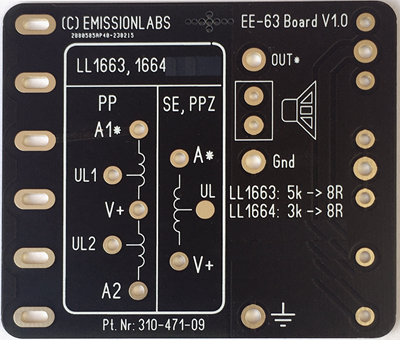Electron Engine ™
Printed Circuit Boards by Emissionlabs
EE63 Transformer Connector Board. Version 1.0
For LL1663, LL1664
Order Nr: 310-063-63
Introduction
We have a copyright on this design.

This is a simple but convenient board. It fits LL1663, LL1664, and works with all versions, , PP, SE or parafeed version (PPZ).
This board eliminates messy wiring. The speaker wires can be soldered into the wire holes Gnd and Out*, or be connected to a terminal block. (not included).
We can supply LL1663, LL1664 in all versions, PP, SE, PPZ, with standard core or amorphous core. PPZ is a special type for PARAFEED Output only.
The board is self explaining, just solder it on the transformer. Connect the speaker, the tube anodes, and supply voltage. Connect the safety ground symbol to the amplifier chassis with a wire.
Some notes about using the EE63 Board.
Soldering
Wires can also be soldered when the board is mounted, because underneath is the transformer base plate, which is made of isolating material.
Single Ended Parafeed
PARAFEED is the ultimate output stage, with a sound of it's own. It uses a Choke, and Push Pull transformer as a Single Ended transformer, but without DC current through the transformer. Yet it requires an optimized PP transformer for this, the so called PPZ Type. The good part of parafeed is, there are little requirements to the choke. It only has to be a high impedance. How high, or linearity plays no role. At the same time, there is no more compromise to the output transformer, as it carries no DC signal. And yet it works the same as SE transformer. If you can digest the cost of a choke, parafeed is the best there is. In addition, a parafeed stage rejects any remaining hum from the power supply a lot better. This is because the choke will reject this easily. Whereas SE ended transformers never have huge inductance, because of the required air gap for the DC current.
Safety ground
The safety ground symbo of the PCB is attached with a wire to the amplifier chassis. Position on the chassis is not important, because it carries no signal current. It only prevents high voltage on the speaker output, in case of a transformer isolation defect. Best is to use a yellow-green wire for it, because then other technicians can see it's intention. Meaning, such a wire carries no audio signal.
Using the EE63 Board in Ultra Linear mode.
This may as well be done in PP mode or on SE mode. Please note, the UL Taps for PP mode are fixed at 33%. For SE mode however, variable taps are possible. Though on the PCB is given a solder island called "UL" for Ultra Linear, you will see it can not be used, because it has no hole, to solder in a wire into. This is only to INDICATE this option optically. The UL Tap for SE use, is taken form the PP connection field, and UL ratio can be choosen from three possibilities. More information and a schematic here.